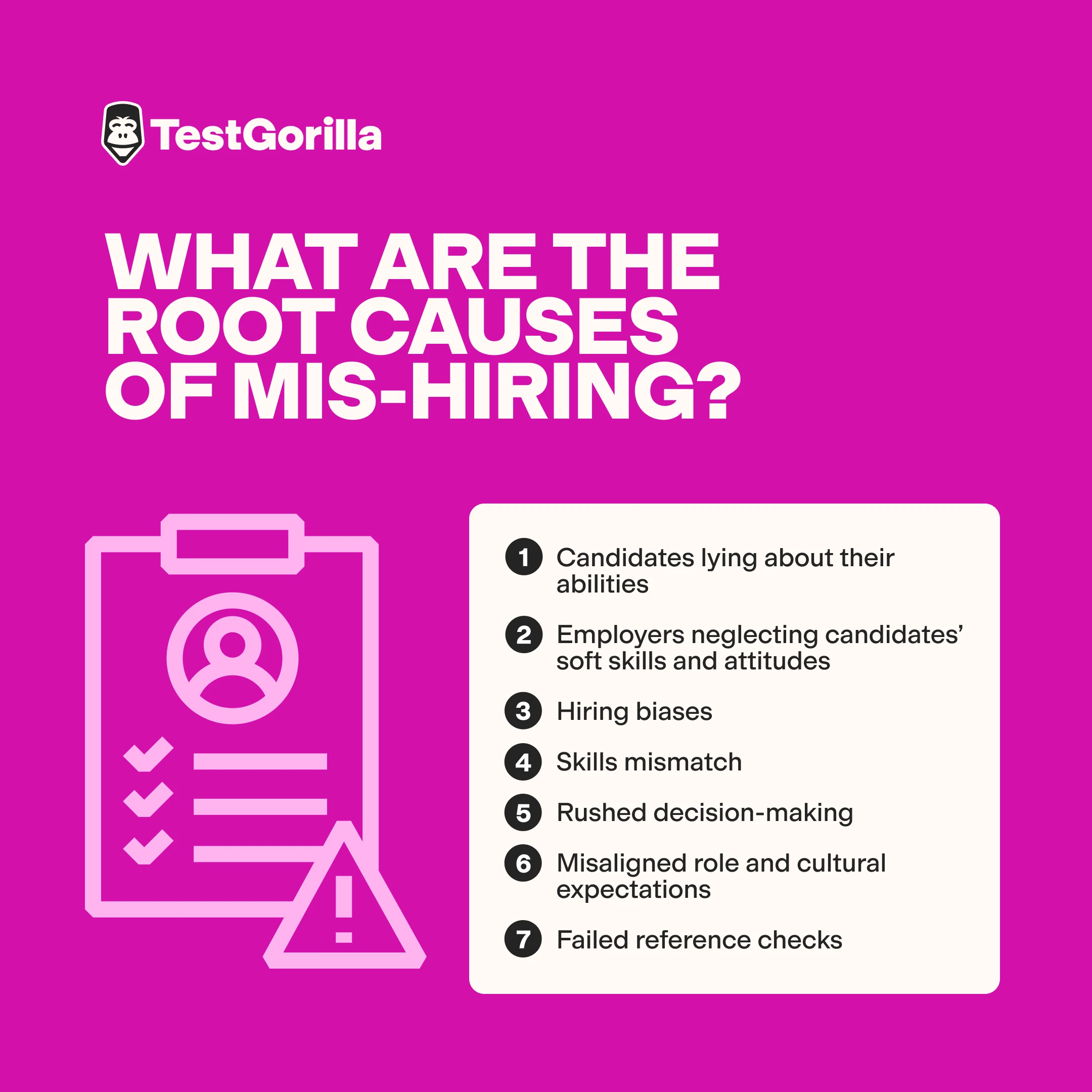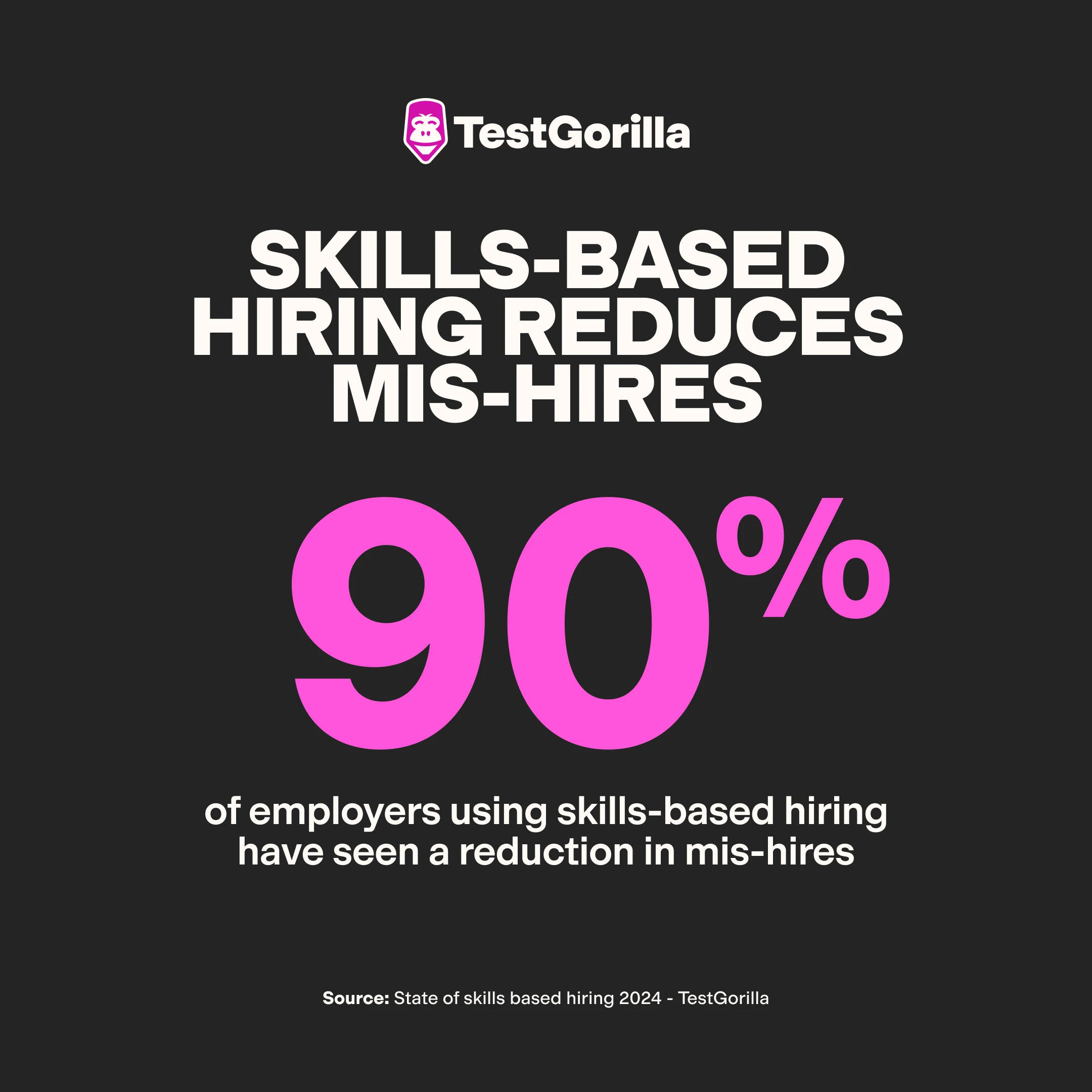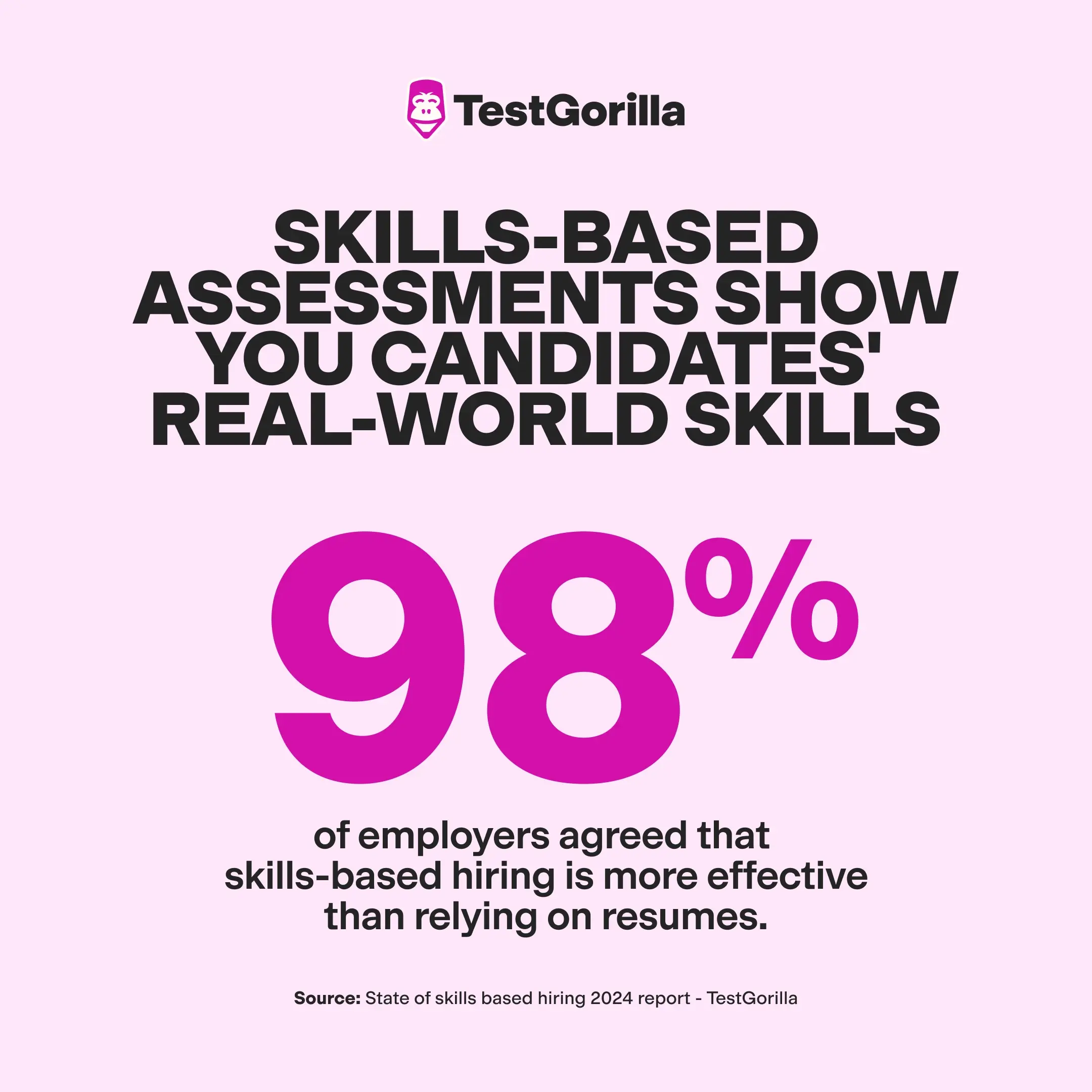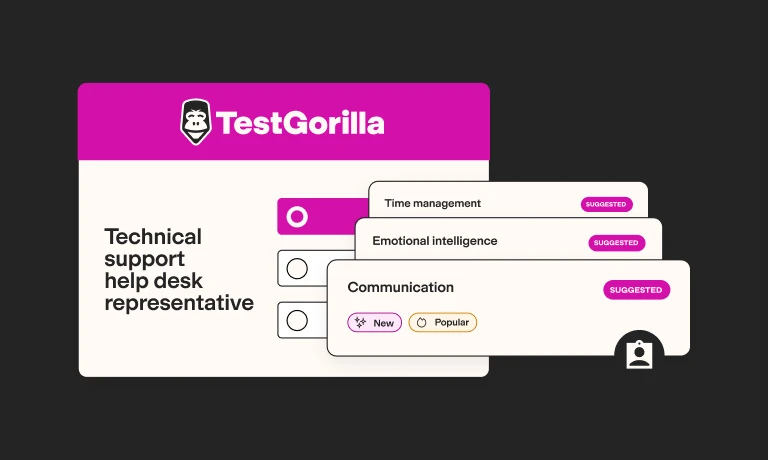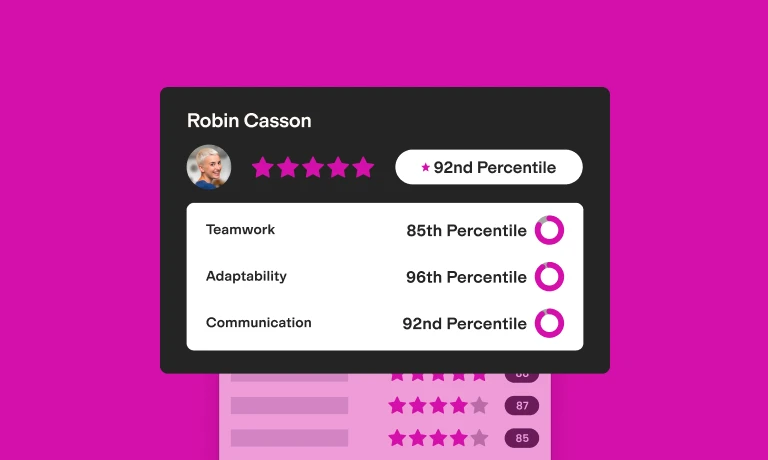Skills-based hiring reduces mis-hires for 90% of employers. Here’s why.
Despite an influx of labor from the tech layoffs, a cooling labor market, and access to more global talent than ever, 51% of employers are having difficulty finding top talent in 2024.
What’s worse – even when you think you’ve found the right person for the job, there’s still a good chance it won’t work out. One study even showed that nearly 75% of recruiters admit to having hired the wrong person for a vacancy – wasting time, resources, and money. [1]
Luckily, things are changing. We recently found that 90% of employers using skills-based hiring have seen a reduction in mis-hires. Why and how is a simple change in approach so effective at cracking this problem?
In this guide, we dive into what skills-based hiring is, why it’s effective at reducing mis-hires, and how you can use it to land the best-suited candidates for your company.
What is mis-hiring?
Mis-hiring occurs when a new hire doesn’t fit well into their job, team, or company, leading to performance issues, employer and employee dissatisfaction, and – in most cases – termination.
According to HR and hiring expert Yashna Wahal, here are some signs that you’ve mis-hired an employee.
The new hire is taking too long to pick up the new role
They’re unable to produce quality work
Their skills don’t align with what was in their application
They’re not meshing well with team members
They have a negative attitude
There are unexplained attendance issues
Despite employers’ best efforts to hire right, mis-hiring is a very common occurrence. Leadership IQ, a research company founded by New York Times’ bestselling author Mark Murphy, found that 46% of new joiners fail within the first 18 months of joining.
Recruitment firm Robert Half found the exact same stat in their study, which showed that 46% of senior decision-makers believed they’d made a bad hire.
Another survey discovered that two in three workers admitted to being recruited for a role and realizing it was a bad fit.
How much does a mis-hire cost a company?
Some employers have estimated the average cost of a bad hire to be more than $18,700. The costs of a mis-hire don’t just include direct costs – unseen costs like revenue loss, missed opportunities, reputational damage, and low team morale that can significantly add to this number.
Costs of mis-hires: A breakdown
Let’s detail some of these costs.
Costs to hire: These include internal recruiting costs, such as a hiring manager and recruiter’s time, their associated salaries, and compliance costs. They also include external costs – like sourcing costs, job posting fees, hiring tech and tools, and so on. The Society for Human Resources Management (SHRM) estimates that the average cost-per-hire in the US is $4,700.
Costs of productivity issues: How much has a mis-hire disrupted your business financially? Assessing this is easier for revenue-generating roles. But for other jobs, you must look at how a new hire and their business area are performing against key metrics and targets to get a sense of what their under-performance is costing you financially.
Loss of clients: Bad hires can cost you your reputation and clientele through low-quality work, bad customer experiences, and more. The Sales Benchmark Index calculated that a mis-hired sales agent earning $100,000 can cost a company over $1 million when you include the cost of losing customers.
Missed opportunities: When you’re busy fixing performance issues and the new hire’s team is still understaffed, you could miss out on potential business opportunities that you would’ve grabbed easily if you’d hired the right person.
Team morale: Some mis-hires don’t gel with their team members, creating a negative work environment. Others don’t produce the expected output, meaning team members must carry the extra weight. Low morale can have a domino effect, leading to more employees struggling to work or even quitting.
Reputational damage: Employees, job candidates, customers, and investors can all question your company’s credibility and decision-making if you consistently mis-hire.
Costs to rehire and train a replacement: In most cases, your mis-hire won’t work out, and you’ll need to replace them. Forbes estimates that it costs about 1.5 to two times an individual’s salary to replace them. This includes the costs to hire, onboard, and train a new employee.
Litigation fees: In rare cases, the cost of a bad hire can skyrocket if the employee decides to sue you for terminating them.
The best insights on HR and recruitment, delivered to your inbox.
Biweekly updates. No spam. Unsubscribe any time.
What are the root causes of mis-hiring?
So, why is mis-hiring so common despite employers’ best efforts to hire the right candidate?
These factors could be causing your mis-hiring problems.
1. Candidates lying about their abilities
The SHRM surveyed 4,000 HR professionals and found that 86% of them had spotted lies in candidates’ job profiles. In another survey, 70% of respondents admitted to lying on their resumes. Employers who don’t find a way to verify their candidates’ skills and abilities can easily hire someone who’s unfit for the job.
2. Employers neglecting candidates’ soft skills and attitudes
Traditional hiring practices focus heavily on candidates’ technical skills – and don’t assess their softer skills, attributes, and attitudes. This one-dimensional hiring can be dangerous. Imagine, for example, hiring a highly skilled head of accounting only to learn they’re a bad people manager or have a laid-back attitude with clients’ accounts.
Leadership IQ’s study found that hiring failures were a result of candidates’ negative attitudes in 89% of cases. A lack of technical skills accounted for only 11% of mis-hires.
3. Hiring biases
Our latest research showed that hiring bias is up by 48% since last year – with over a third of candidates reporting they’ve experienced biases in the hiring process.
Overall, recruitment is highly prone to biases. For instance, some decision-makers might consciously choose candidates from their personal networks – even if they’re less skilled than other applicants.
Other biases are unconscious – for example, prioritizing a candidate from the same country as yourself (an in-group bias) or assuming that a candidate who is “nice” will also be quick to learn (the halo effect). In fact, in one study, 32% of employers who mis-hired said it was because they took a chance on a nice person.
4. Skills mismatch
Hiring someone whose skills match the role’s needs seems obvious right? Well, a survey by Robert Half found that three in five senior decision-makers said choosing a candidate whose skills didn’t match the job’s requirements was the biggest cause of mis-hiring.
Part of this can be attributed to the skills shortage and challenging labor market forcing employers to make subpar hires to fill positions. Meanwhile, some employers don’t properly verify their candidates’ skills before hiring them, some don’t have the right tools to test candidates’ abilities, and others assume that educational qualifications or experience are enough to measure an applicant’s suitability for a job.
5. Rushed decision-making
The same Robert Half survey found that 56% of senior decision makers believed their mis-hiring was a result of a rushed hiring process. In another survey, 30% of respondents said their bad hires were linked to the pressure to fill a role quickly.
We get it – in this highly competitive job market, moving too slowly can cost you top talent. Plus, a longer time to hire means you’re losing revenue and missing opportunities. When done incorrectly, though, fast recruitment can lead to flawed hiring decisions.
6. Misaligned role and cultural expectations
Vague or confusing job descriptions can lead to candidates misinterpreting the role and responsibilities.
For example, by stating you need a candidate “skilled in Excel,” you could end up with someone who knows their basics but isn’t familiar with the formulas they need for the job.
Some employers also forget to specify important information like flexibility or working hours, which is key to today’s employees. Imagine hiring someone who’s expecting a 9-5 role when, in reality, the role often calls for late evenings or weekend work.
Additionally, not checking if candidates will fit into and contribute to your company’s culture is problematic. You could, for example, hire someone with all the right skills – only to learn they’re racist or sexist and don’t align with your company’s values.
7. Failed reference checks
A recent Forbes article explained that former employers aren’t always forthcoming about candidates’ downsides because they fear being sued for bad-mouthing them.
Reference checks can provide insights into a candidate’s skills and traits, but they’re not always honest – often leading to misrepresentations that can cause mis-hiring.
Why skills-based hiring prevents bad hires
Skills-based hiring is a recruitment approach that focuses on candidates’ real-life skills for a job – removing the emphasis from educational qualifications and prior experience. Any application process that assesses individuals’ skills through tests, structured interviews, simulations, practical tasks, and so on forms part of this approach.
In our latest and most comprehensive study to date, we surveyed over 1,000 employers and employees and discovered that 90% of employers using skills-based hiring practices have seen a reduction in mis-hires.
What’s more – skills-based hiring helped US employers save up to $22,500 by reducing mis-hires in roles that paid about $60,000 in annual salary.
James Wilkinson, CEO of Balance One Supplements, also shared the company’s first-hand experiences using skills-based practices.
A recent internal study conducted by HR reports that in the time since we introduced the skills-based hiring approach, our mis-hire rate has dropped by 75%.
We are on-boarding [sic] people who are able to hit the ground running, making a meaningful contribution from day one. This translates directly into greater productivity, and amplified team spirit.
So, why does skills-based hiring prevent mis-hiring? Let’s dive into some results from our study.
1. Helps with shortlisting qualified candidates
Fifty-three percent of employers said that skills-based hiring helped them get to a smaller pool of qualified applicants quickly.
Today’s job market is very competitive, with hundreds of applications pouring in for open positions. When you screen applications with concrete metrics like test scores, you eliminate countless unqualified candidates right away. This saves time and reduces your chances of hiring someone unfit for the job.
2. Rooted in hard facts, not assumptions
Ninety-eight percent of employers agreed that skills-based hiring is more effective than relying on resumes.
Skills-based assessments show you candidates' real-world skills. This way, you’re not making screening decisions based on unverifiable pieces of paper.
Plus, you’re selecting candidates based on their abilities today, rather than making assumptions based on their previous experiences or qualifications. In fact, 63% of our respondents said skills-based tests let them see the true potential of a candidate – rather than just the experience they’d gotten so far.
3. Provides a holistic view of candidates’ suitability for a job
Fifty-six percent of employers said skills-based hiring helped them verify applicants’ soft skills, while 54% found it helped with validating hard skills. Fifty-three percent felt it helped them verify cognitive abilities.
A true skills-based process will help you learn about applicants' hard and soft skills, cognitive abilities, and even their personality traits. This provides a well-rounded view of their knowledge, skills, preferences, working styles, and so on.
This reduces instances of hiring someone unskilled and prevents you from selecting someone who doesn’t have the right attitude, will struggle to gel with their team, or won’t mesh with your culture.
4. Helps predict on-the-job success
Ninety-four percent of employers agreed that skills-based hiring is more predictive of on-the-job success than resumes.
Skills-based hiring typically tests candidates on the actual skills they’ll be using in a role – what better way to ensure you’re hiring the right person?
And another study by Harzer and colleagues showed that even certain personality and cognitive skills tests were strong indicators of job performance.
5. Reduces hiring bias
Eighty-four percent of employees feel that skills-based hiring helps reduce conscious and unconscious biases in hiring.
Skills-based hiring methods provide an objective way to screen and select candidates. This helps to eliminate biases and ensures everyone gets a fair shot at proving their abilities, regardless of their background, prior experiences, gender, race, and so on.
6. Enables candidates to self-assess job fit
Eighty-five percent of employees claimed that skills-based hiring helped them to better understand the requirements for a job, and 67% said it gives them a chance to see which skills they’ll use in a role.
When candidates take skills-based assessments, they gain insights into which skills and traits spell success in a job. This helps them decide if they’ve got what it takes to do the job. Plus, it helps them think about whether they actually like the work involved.
Those unhappy with what they see can drop out of the process early on rather than wasting time and resources only to leave soon after joining.
How to avoid mis-hiring
Switching to a skills-based hiring approach is the ultimate way to reduce mis-hiring. Do this by writing clear skills-focused job descriptions, using multi-measure talent assessments, making data-driven decisions, and conducting thorough background checks when needed.
1. Write clear, skills-based job descriptions
Write job descriptions that focus on skills rather than educational qualifications and experiences.
This opens your doors to STARs – those skilled through alternative routes such as self-learning, on-the-job training, and online courses. And, it helps prevent you from settling for less-skilled talent simply because they have a fancy degree or have previously worked at a well-known company.
Additionally, make sure your job descriptions are clear and simple to understand by providing relevant details but avoiding confusing or overly complex terms.
For instance, instead of saying something ambiguous like “The candidate will be responsible for handling various marketing activities,” try “The candidate will lead digital marketing campaigns across social media, email, and pay-per-click.”
2. Use talent assessments early in the screening process
Talent assessments are tests you can use to evaluate your candidates’ skills for a job. They’re a core part of a skills-based hiring approach, as they give you a quick, fair, and effective way to weed out unqualified candidates and reduce the likelihood of hiring someone unskilled.
To make the most of talent assessments, however, use them as early in the hiring process as possible. By replacing resume-screening with talent assessments, you won’t need to go through the drill of scanning resumes and cover letters. Instead, you’ll shortlist only those with the essential skills for the role – and there’ll be less room for bias.
That said, we’ve found that most employers still screen resumes in addition to using skills-based assessments. If you’re still using resumes, we recommend screening them after assessing candidates. Our data showed that the 33% who use skills-based hiring first were happier with their hires.
3. Go for multi-measure testing
Put candidates through multi-measure talent assessments that provide you with well-rounded insights into various “measures”: technical skills and knowledge, soft skills, situational judgment, cognitive abilities, and even behavioral attributes. This helps you assess a candidate’s overall job and ability to enhance your culture – rather than just their hard skills.
Pick a testing platform that offers tests for the skills and qualities you’re looking to assess. Additionally, put shortlisted candidates through structured interviews with fixed sets of questions you ask all candidates. This helps to dig deeper into their thought processes, working styles, and more so you can avoid picking someone who doesn’t seem to align with your company’s culture or working practices.
4. Conduct background checks if needed
Vet your candidates properly before you hire them. It may be best to avoid biased and subjective reference checks and use objective background checks only. This is especially true if you’re operating in a highly sensitive or regulated industry like healthcare or finance.
You can do this with the help of your in-house team or an external background check agency. It’s best to conduct your background checks right before you make an offer – after you give candidates a good opportunity to prove themselves.
That said, at TestGorilla, we believe in fair chance hiring and encourage employers to look beyond a candidate’s past when hiring them – where appropriate, of course.
We don’t recommend rejecting skilled candidates – but gathering accurate data beforehand can help you make informed decisions and avoid surprises like inaccurate background information, right-to-work status issues, criminal records, financial liabilities, and so on.
Put an end to mis-hiring with a skills-based recruitment approach
Most employers mis-hire at some point. Mis-hiring may be common, but it’s no small deal. It leads to low productivity, delayed projects, loss of revenue and clients, poor team morale, and so much more.
Luckily, many employers using skills-based recruitment have found it’s not only effective and easy to implement but also significantly reduces both the costs and instances of mis-hiring.
Take advantage of these benefits by writing skills-focused role descriptions and using multi-measure talent assessments. This way, you can start hiring faster, cheaper, and better. Don’t just take our word for it – use our ROI calculator to see how much money skills-based hiring can save your company – on mis-hires and more.
You've scrolled this far
Why not try TestGorilla for free, and see what happens when you put skills first.


